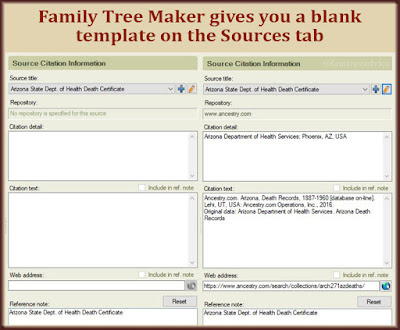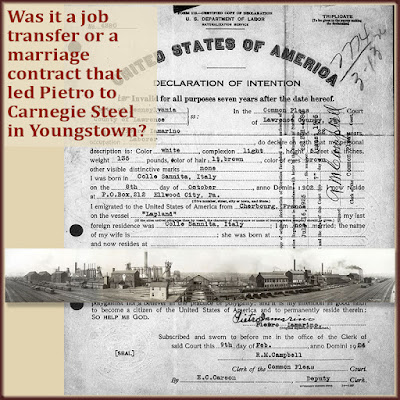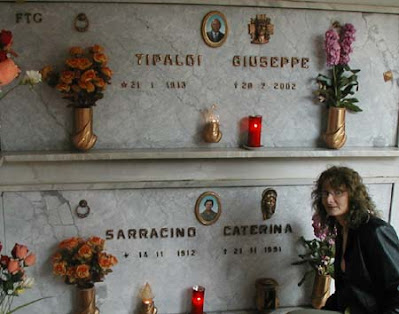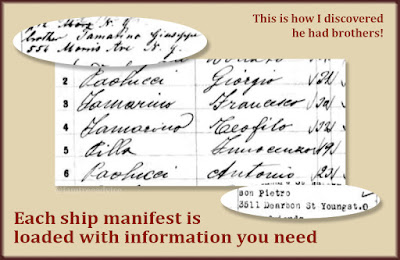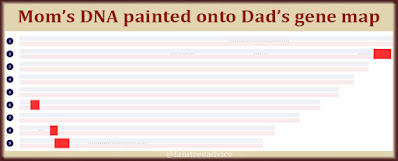My 12-year-old task list is a big help to my genealogy research today.
As soon as I realize I can't find a document for a person in my family tree, I make a note. I want to document that fact that I searched for this record, but I couldn't find it.
If I add a note like this to someone in Family Tree Maker, I also add a bookmark to the person. The bookmark in the index of names is a sign that there's something about this person I haven't figured out.
An even better option is to add a task to this person in Family Tree Maker. Your task list is the first thing you see each time you open your family tree file.
 |
| Document those unfinished tasks and family mysteries. Some day you may find the answer. |
If you don't use Family Tree Maker, look for similar options in your genealogy software. If all else fails, you can keep a text file of all the little family history mysteries you'd like to solve one day. You might want to list them alphabetically by the person's name, and add the date you recorded the note.
Let's look at one of my tasks and what I can do to solve it.
Teofilo Iamarino was my great grandfather's brother. The task I recorded for him 7 years ago is, "Did he stay in the US? Check for 1910, 1920 census." Let's see what I do know about my 2nd great uncle Teofilo:
- I have his Italian birth record from 1876.
- I have his Italian marriage record from 1896.
- I have his February 1909 ship manifest. He arrived in Boston, but headed to New York with my great grandfather and other relatives. My great grandfather came to America a handful of times, worked, and went back to Italy.
- I have Teofilo back in Italy for the October 1912 birth of his son. He has to have been in Italy since at least January 1912.
- I have his 1918 U.S. World War I draft registration card when he lived in Detroit, Michigan. The card says his nearest relative is his wife in Italy. I'm a little surprised that he had to register. He was a non-declarant alien who had no plans of becoming a U.S. citizen.
- I have him in Italy for the July 1923 birth of his daughter. He has to have been in Italy since at least October 1922.
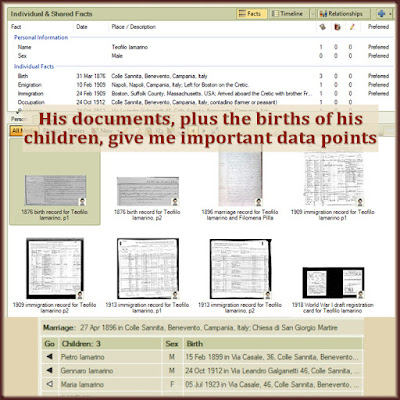 |
| Each document you find may be a clue that leads you to the next. |
That timeline of known events tells me:
- He may have been in New York for the 1910 census.
- He may have been in Detroit for the 1920 census.
I'm not sure if I ever looked for Teofilo in Michigan, so I can check the U.S. census and include his Detroit address.
Nothing.
When I take out the Michigan address and hope to find Teofilo anywhere in 1910, I also get no results.
I can do a broad search for any documents I don't already have. I can leave off his last name and search for any Teofilo born in Italy in 1876.
Hurray, I found something new! I found Teofilo and 3 other men from his hometown arriving in New York in September 1913. According to the documents, he was in Italy in 1912. But he returned to New York for more work, leaving his wife to care for their young children.
In 1913 Teofilo returned to his brother Giuseppe's home in the Bronx. That's the same Giuseppe my great grandfather often returned to. It's the same Giuseppe my dad lived with as a toddler.
But wait! There's more. On the ship manifest, when asked if he had been in the U.S. before, Teofilo says yes, he was in New York from 1909–1911. That bit of information goes straight to the question I've been trying to answer: Was Teofilo in the United States for the 1910 census? If this ship manifest is right, then yes, Teofilo should have been in New York for the 1910 census.
 |
| I don't know why he's in Detroit, but now I know when he was in New York. |
Teofilo's brother Giuseppe has no boarders living with him in the 1910 census. It's only Giuseppe, his wife and daughter. Is Teofilo in another household nearby?
I can return to Giuseppe's 1910 census online because I always note exactly where I found an image. I can go page-by-page looking for Teofilo.
I love paging through a Bronx neighborhood in the census. I recognize most of the last names. They're names from my ancestral hometowns, or they're names of my parents' friends and neighbors.
Unfortunately, Teofilo was not in that 56-page census collection. But I can look at other collections that are in the same general neighborhood. The important thing is, I now have reason to believe Teofilo is there.
Before I look for more documents, I want to check out the other townsmen with Teofilo on that ship in 1913. One of them, Francesco Pozzuto, is a good fit with someone in my family tree. He may be the father of a woman who is a critical DNA match. She and her son are DNA matches to both my father and my mother. I'm adding a note and a bookmark to him right now.
This example shows the value of creating these tasks or bookmarks. Years can go by. Without that note, I wouldn't have realized I needed to do more research on Teofilo Iamarino. There are literally 21,000 other people in my family tree.
But today I felt like looking at my task list in Family Tree Maker. And I wound up discovering a ship manifest for Teofilo with a very important clue.
Genealogy is a long game. Leave detailed notes for future-you whenever you can.
